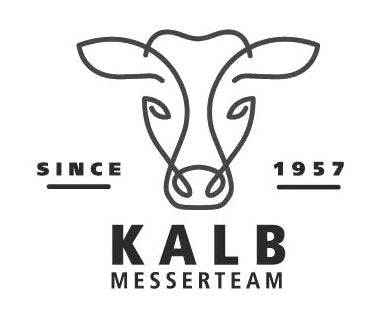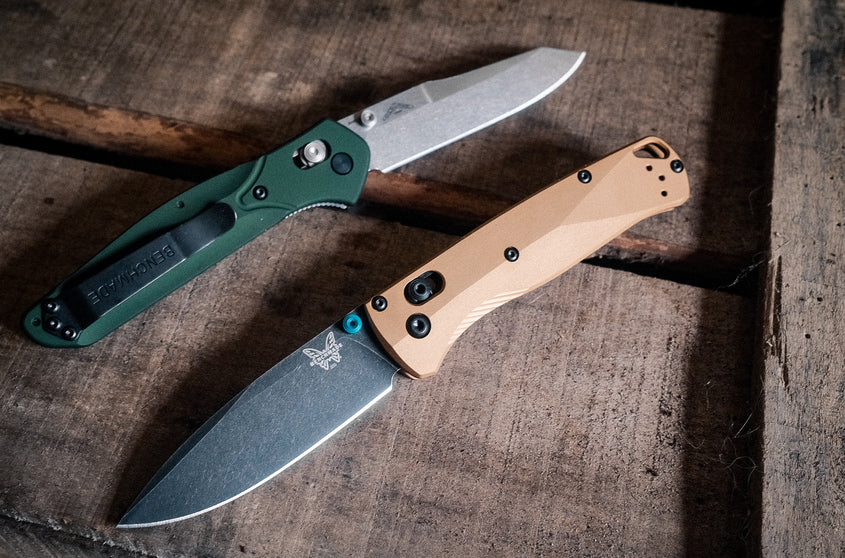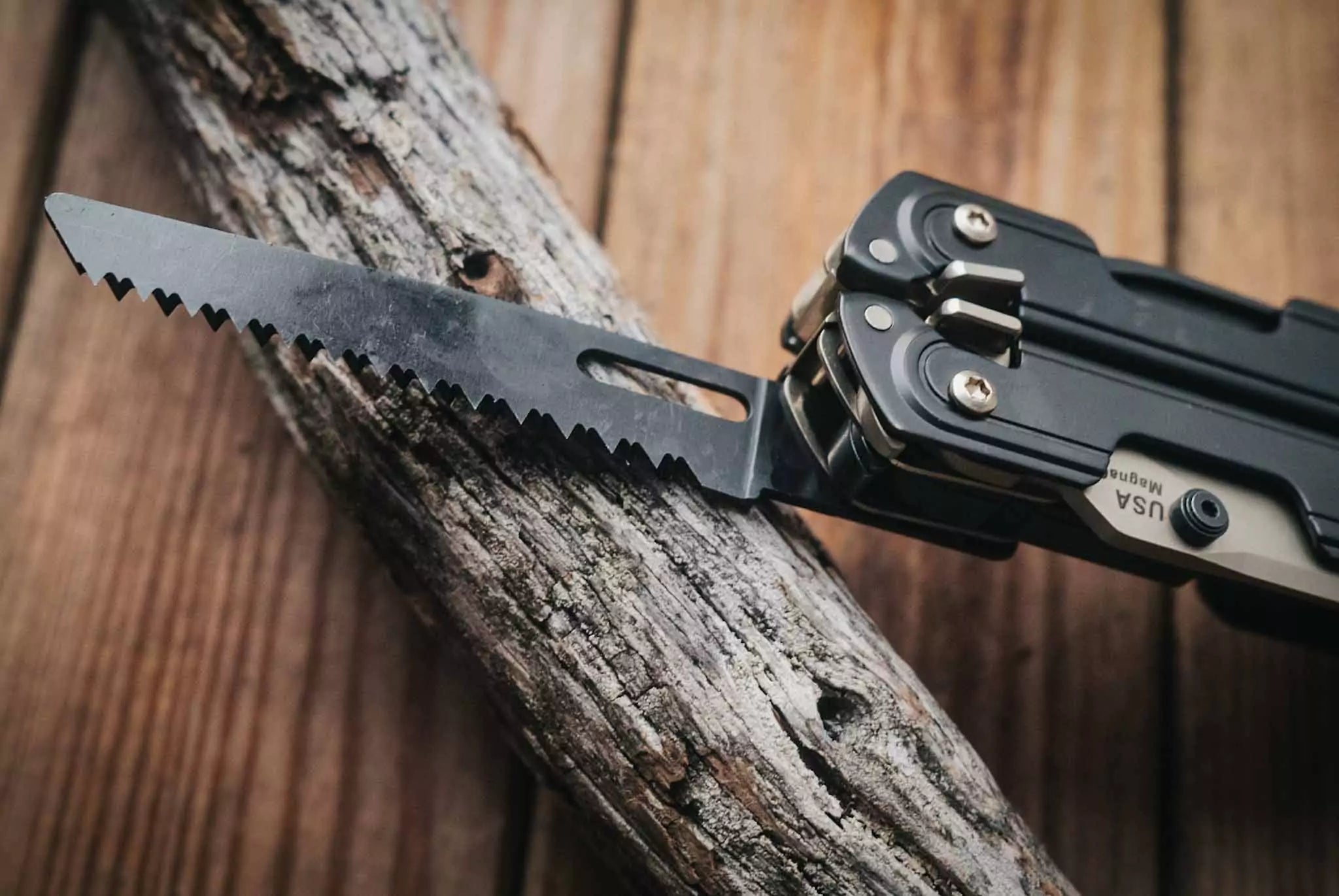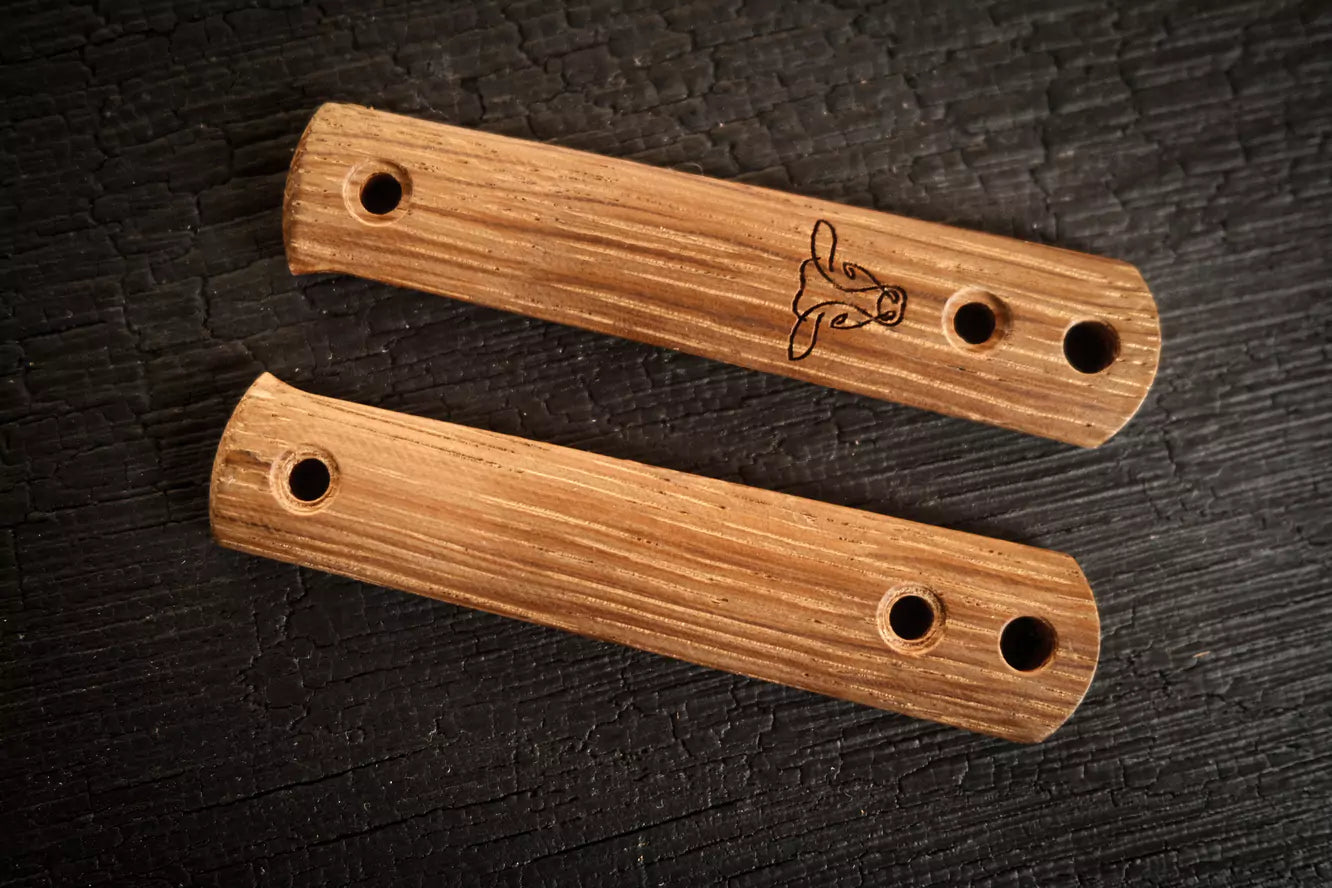Bushcraft knife guide: Which bushcraft knife should I buy?
We all know it, us outdoor children: We want to get out into the woods, unwind, feel connected to nature, go on little adventures, treat ourselves to a break from everyday life – but let's be honest: The real fun comes from having the right equipment, and a decent bushcraft knife is something like our holy grail when we follow in the footsteps of our role models like Ray Mears and Horace Kephart.
Contents:
- What exactly is bushcraft?
- What is important when choosing a bushcraft knife?
- The perfect bushcraft knife
- The right blade length
- The right blade shape
- The agony of choice when it comes to steel
- Full Tang vs. Partial Tang
- Price ranges: What should you spend?
- Conclusion: The best bushcraft knife for you
What exactly is bushcraft?
Before we delve into the ins and outs of bushcraft knives, let's first clarify what bushcraft actually is. The term comes – unsurprisingly – from the English and is composed of "bush" (bush/wilderness) and "craft" (craft/skill). Bushcraft, in the broadest sense, refers to the ability to survive in the wilderness with minimal equipment and to utilize the available natural resources. From this point on, however, opinions differ as to what exactly bushcraft should look like, and there are numerous schools of thought, philosophies, and attitudes that offer their own definitions. Am I already a bushcrafter if I carve my own tent peg in the forest? Can I start my campfire with a lighter, or does it have to be a fire steel? Or is only rubbing sticks allowed, because everything else is considered glamping? To be "real" bushcrafting, do I have to do several overnight camps in the Carinthia Defence 4 over the weekend, be able to set up my tarp in at least five different ways, and sizzle my food over an open flame with the latest knife hit from the YouTube charts? Or am I already "bushcrafty" enough if I dive into the local state forest for three hours after work, prepare nettle fibers for cordage, and identify five edible plants along the way?
Bushcraft vs. Survival vs. Camping: What's the Difference?
This question is just as passionately debated as the definition of bushcraft itself:
- Bushcraft is primarily about acquiring knowledge and skills that enable you to live as comfortably and sustainably as possible in and with nature. "The more you know, the less you carry" – in other words: the more knowledge I carry, the less (equipment) I have to lug around – was bushcraft legend Mors Kochanski's motto. Bushcraft is a conscious decision to spend time in nature to test and expand one's knowledge and skills.
- Survival is primarily characterized by an acute emergency situation – the goal is to extricate yourself from critical situations or survive a critical situation until help arrives. There are many overlaps with bushcraft in terms of knowledge and skills: The better equipped I am with my knowledge of my environment and my ability to utilize it to my advantage, the greater my chances of survival should I find myself in an emergency situation. Unlike bushcraft, however, you don't enter an emergency situation voluntarily; rather, you find yourself there involuntarily and usually unexpectedly, and you have to cope with the local conditions on the spot.
- Camping is almost exclusively about recreation and leisure – all the comforts of civilization, such as tents, sleeping bags, camping stoves, and the like, are brought into the wild. The primary goal here is to combine the enjoyment of nature with the conveniences of home, without requiring any prior knowledge beyond roasting sausages over a fire pit.
What is important when choosing a bushcraft knife?
If bushcraft, in the broadest sense, is about living in and with nature , and where craftsmanship in handling natural resources is paramount, good tools are the key to enjoyment and success. "Good" doesn't necessarily mean expensive, and "tools"—recalling Mors Kochanski's motto "The more you know, the less you carry"—don't mean stumbling into the woods with a whole suitcase full of tools. For most outdoor enthusiasts, a saw, an axe or hatchet, and a good knife are sufficient. But what exactly makes a good bushcraft knife , what features should it have, and how much money should I spend on it? We'll explore these and other questions in more detail below.
The perfect bushcraft knife
To be clear: there is no such thing as the perfect bushcraft knife . This starts with the most important part of the knife: the handle. Every hand is different, everyone experiences grip comfort differently, and not every knife handle will be suitable for every hand – neither in terms of size nor ergonomic factors. The knife handle is essential when it comes to comfortable and safe working with this tool. If the knife doesn't fit well in your hand, fatigue, pressure points, or even blisters quickly develop, and the joy of using the knife is gone.
The knife's intended use is also crucial: Do you primarily use your knife for carving and finer woodworking? Are you looking for a one-tool option that lets you do a bit of everything—carving, chopping, splitting wood, peeling apples? Or do you primarily enjoy being outdoors because you prefer cooking outdoors and therefore tend to prefer sharper blades? Let's take a closer look at each aspect:
The right blade length
Too short is impractical, too long becomes unwieldy. The happy medium for many bushcraft knives is on average a blade length of around 8 to 12 cm . This gives you enough of an edge for most tasks without the knife becoming too bulky, although 12 cm is already the upper limit for many people. Since batoning (splitting wood with a knife) is an important requirement for many people, the blade should not be too short in this case, as otherwise only very thin twigs can be worked on. If, on the other hand, you place more value on the knife being easy to handle so that you can also carry out more delicate work, a blade length of around 8.5 to 10.5 cm is the optimum for most users.
The same applies to blade thickness , i.e., the thickness of the blade spine: The rougher the work you typically intend to perform with the knife, the more suitable a thicker blade spine (3.5 to 5 mm) is. A bushcraft knife with a 12 cm blade and a blade thickness of 4 mm will have significantly better splitting properties than a bushcraft knife with a 9 cm blade length and a blade thickness of 2.5 mm. The latter, in turn, will be significantly better for carving or smaller, recurring tasks.
The right blade shape
Some blade shapes are popular for bushcraft knives:
-
Drop-point : One of the most common blade shapes for pocket and outdoor knives, due to its versatility. The slightly tapered tip offers a good balance between control and stability, while the edge maintains a balanced curve, which is particularly advantageous for hunting or outdoor cooking. Perfect for versatile use in the forest. Bushcraft classics like the Böker DBK Bushfriend 2000 are typical examples of drop-point blades.

-
Spear point : This is where the spine and edge meet exactly in the middle, so that the blade tip lies on the centerline of the blade. This blade type became famous primarily through the Kephart knife, but can also be found in the iconic Woodlore design, which was popularized by Ray Mears. The BPS B1 is a classic example of a Woodlore knife. The spear point's main advantage is the outstanding controllability of the blade tip, which is beneficial for various carving techniques, but also for drilling holes in wood (e.g., when making a fire drill board).

-
Clip-point : This blade shape (also known as a pike blade in German-speaking countries) is particularly popular in hunting and some combat knives, as the sometimes very fine blade tip, thanks to the (concave) sloping blade spine, is particularly well-suited for stabbing or precise cutting/slashing. The classic Buck 110 or Buck 112 is a stereotypical example of a strongly pronounced clip point, but more discreet clip-point variants like the Cold Steel SRK are also popular, especially in the outdoor sector.

-
Sheepsfoot blade : The sheepsfoot blade shape is characterized by the blade spine sloping completely down to the cutting edge, resulting in little to no bulge, making this geometry ideal for long, pull cuts. Kitchen knives like Santokus or the popular Windmühle knife are classic examples of sheepsfoot blades, but the iconic Otter Anchor knife and Guido Bayer's Waldläufer are also popular for use in the forest.

Of course, there are numerous other blade shapes as well as variations and grades of the blade shapes mentioned above, which we will soon discuss in a separate blog post.
The agony of choice when it comes to steel
Knife steel: Advantages, preferences, and sometimes incorrect or outdated ideas about steel properties repeatedly lead to heated discussions and almost religious wars between individual opinions. While this is partly understandable (especially among knife makers, who inevitably have to deal with metallurgy, alloys, steel compositions, austenitic and martensitic steels, or heat treatment processes), it is often based purely on personal preferences and has no relevance for general use. At this point, we want to address the question of steel type briefly and concisely, without getting bogged down in details. Let's focus on the most fundamental of all questions: carbon steel or stainless steel ?
But first let’s clear up a few misunderstandings:
Stainless (or better: rust-resistant) steel does not mean that this steel cannot rust. The corrosion resistance of steel depends primarily on its chromium content, but also on the influence of other alloying elements on the steel, on the size or even the mere presence of chromium carbides, and a few other factors. Depending on the exact composition and treatment of a steel, it can be more or less rust-resistant – but there is no guarantee that it will never rust. Severe weather conditions, salt water, deposits, and the like can certainly attack even rust-resistant steel. In principle, however, rust-resistant steel is much easier to maintain and better protected against rust than, for example, plain carbon steel.
The old wisdom that carbon steel is easier to sharpen than stainless steel is not (or no longer) necessarily true. Here, too, carbide structure, heat treatment, and alloying elements play a key role. In real life, however, it will make little difference whether you sharpen your Mora Companion with 12C27 stainless steel or your Mora Companion with C100 carbon steel – excellent sharpness can be achieved with both steel variants, so one steel is in no way inferior to the other. Individual experiences may vary, but a general statement that " carbon steel is easier to sharpen than stainless steel " is not universally true and depends far more on the steel quality , the manufacturing process , and your own skills on the grindstone . The statement that " powder metallurgical steels are generally more difficult to sharpen than conventional steel " is much more accurate – but that is a chapter in itself.
Carbon steel
Carbon steel has its raison d'être and is particularly popular for bushcraft knives. There are probably two primary reasons for this: Firstly, many bushcrafters associate their hobby with tradition and historical models , especially with times when knives were predominantly made of carbon steel. Nostalgia and old-school vibes resonate very strongly here, and the characteristic patina that forms on carbon steel blades tells its own story. Pure romance. Secondly, it is probably also because many smaller knife makers or manufacturers like to use carbon steels because they are easy to work with in knife production and can generally be heat treated more easily , which is an important part of the manufacturing process for small businesses. This primarily creates the impression that bushcraft knives are typically made with carbon steel - without there necessarily being a technical reason for this for the user.
Carbon steels commonly used for entry-level bushcraft knives are 1095 (AISI) or C100 (UNI), 80CrV2 , or O1 . With carbon steel, thorough care is essential. This means keeping the blade clean and dry, regularly conditioning and oiling it (e.g., with camellia oil or food-safe mineral oil), and generally protecting it from moisture, humidity, and high-humidity weather.
Rust carrier steel
Rust-resistant steel is in no way inferior to its corroding counterpart, and inexpensive entry-level steels like 12C27 or 14C28 in particular impress with their tremendous price-performance ratio. Sharpenability is by no means inferior to carbon steels, and the durability of the cutting edge (i.e., how quickly the edge becomes blunt again) is also very good. Of course, this isn't meant to be a general statement, as quality must be differentiated here – as is so often the case, it depends on the composition of the steel, the manufacturing process, and also the quality of the knife production (especially the heat treatment). Therefore, there is fundamentally no objective reason to choose carbon steel over rust-resistant steel when choosing your bushcraft knife if rust resistance and significantly lower maintenance requirements for your bushcraft knife are important to you.
Classic examples of stainless steels for entry-level bushcraft knives are 12C27 , N690 or AUS8 .
Powder metallurgical steels
Powder metallurgical steels have long been gaining ground in the mass production of knives, offering enormous advantages in terms of hardness, edge retention, rust resistance, and much more. Powder metallurgical steels involve mechanically compacting and sintering metal powder with its various alloying components, resulting in a much finer material structure with significantly smaller carbides, which leads to significantly improved steel properties. PM steels can also be rust-resistant or non-rust-resistant. The well-known CPM 3V, for example, has a chromium content of approximately 7.5%, which means it is not considered rust-resistant and is therefore more susceptible to moisture and humidity.
Well-known representatives of PM steels in bushcraft knives are CPM 3V , RWL-34 and MagnaCut .
So which steel is right for me?
At the end of the day, the question of steel shouldn't be too much of a focus. With modern knives and today's steels, questions regarding edge retention, sharpenability, and the like can no longer be broken down purely into carbon steel vs. rust-resistant steel, but depend primarily on the respective alloy components, manufacturing processes, and heat treatments. Since this opens up a very complex field, which we will explore in more detail in a separate blog post, simply ask yourself the following questions :
- If rust resistance or low maintenance are important to you, then choose rust-resistant steel .
- Is it important to you that your bushcraft knife tells a story and has a classic design? Choose carbon steel .
It is advisable to first decide on a suitable knife based on its intended use and handling , and to consider the steel question as a secondary consideration .
Handle material: Comfort is king
A knife that causes blisters after an hour of carving is not a good companion. The right handle shape for the individual hand is therefore crucial, as already mentioned at the beginning. However, the handle material is also crucial, as it not only influences the comfort of a knife, but also its robustness and maintenance requirements. A few common and popular handle materials are:
- Wood : Traditional, beautiful, and comfortable to hold, but requires more maintenance and is more likely to break or splinter from falls, etc. Stabilized wood (i.e., wood stabilized with an epoxy solution in a vacuum) greatly increases the durability of the handle, but is also significantly more expensive.
- Micarta : Linen or cotton fiber pressed with resin. Robust, grippy even in wet conditions, indestructible, and with a very high-quality and stylish appearance. An absolute favorite among bushcraft knives.
- G10 : Similar to Micarta, but made of fiberglass – extremely durable and easy to maintain, but has the typical "plastic look" and is often considered less aesthetically pleasing.
- Rubber grips : Provide excellent grip in wet conditions, but depending on the composition and plastics used, can become sticky or brittle with age.
Full Tang vs. Partial Tang
The question of all questions: Does a bushcraft knife have to be full-tang, meaning the tang extends the full width of the blade through the handle ? Admittedly, the idea of a full-tang construction is very reassuring, especially if you plan on using your bushcraft knife for a bit of woodland thrashing. However, this is absolutely not a requirement, as long as you handle your knife carefully and appropriately for its intended purpose . Historically, generations of our ancestors survived the wilderness with tang blades, the best example being puukkos.
With the trend of wanting to fell trees and baton logs with one's jack-of-all-trades bushcraft knife, it is at least questionable whether a knife is still the right tool for this. With the right technique and the necessary care, one can easily perform rougher work with a knife with a partial tang or a tang – and yes, I have often batoned with a Mora Companion without any problems and also performed other, rougher work without anything ever happening to the knife (which is no Recommendation is to do this!).
The decision question is therefore primarily aimed at the intended use :
- Partial tang/stecker is completely sufficient for knife-appropriate work such as carving, cutting, crafting, as well as light and responsible chopping/batoning.
- Full tang is recommended for tougher tasks such as chopping, prying, breaking, levering, batoning – or when you simply don't want to worry about it.
Price ranges: What should you spend?
Good news: A functional bushcraft knife doesn't have to be expensive. At the end of the day, it all comes down to how well you handle your bushcraft knife, and that requires practice and skill. If you've never used a knife before, even a €300 knife won't make you a master overnight. Quite the opposite: Mors Kochanski, one of the biggest names in bushcraft, spent his life working with cheap pocket knives and a simple, inexpensive Mora from a hardware store (for those interested in knowing more: one of his most frequently used models in later years was a KJ Eriksson 511. You can find more information and background on Mora knives in our guide " Which Mora is the best? ").
But even dual survival legend Cody Lundin relies on his trusty Mora Classic with a red wooden handle. So we see: Even affordability works. But it's not always just about the price; it's also about the feel: If we consider our bushcraft knife the holy grail, an extension of our arm, then the overall package has to be right. And let's face it: For most of us, we don't stick with just one knife anyway... So let's get an overview of which knives we can look at in which price range:
- Beginners (15-50 €) : Here you will find solid workhorses such as various Mora models, but also Böker or Victorinox and Opinel – inexpensive, functional and really good for most applications.
- Mid-range (€50-200) : This is where the world of knives "made for life" begins. Better steels, more sophisticated ergonomics, and higher-quality materials are at home here, with manufacturers like Lionsteel, Casström, Böker, and Fällkniven.
- High-end segment (>€200) : This is where the semi-custom segment begins, such as Bark River and LT Wright, but also models from high-end brands like Tops, Benchmade, or TRC. This market is aimed more at connoisseurs, collectors, and enthusiasts who specifically spend their money on these types of knives, because the price of a knife doesn't increase in proportion to its features.
- Custom segment : Consciously separated from manufacturer's products, we find the segment of custom knife makers. It's impossible to specify a price range here, as prices can vary enormously depending on location, experience, and the knife maker's quality. It's also worth taking a look at neighboring companies like Emil Handmade Knives from Poland or Rob Evans from Wales, who build excellent knives.
Conclusion: The best bushcraft knife for you
The "best" bushcraft knife is ultimately the one you're most comfortable with. A €300 knife sitting in a drawer is worth less than a €30 knife you take with you on every forest outing. When choosing the right bushcraft knife, you should primarily consider the following criteria:
- What purpose should it serve? Carving, chopping, slicing, cooking?
- How does the handle feel? Can you work comfortably with the knife for extended periods?
- Does the handle material suit the intended use and your personal requirements for robustness and aesthetics?
- While choosing the right steel is important, it shouldn't be the main focus. What good is a Magnacut blade if I get blisters after slicing apples three times?
Admittedly , there's only one way to find out whether a knife feels good in your hand. Feel free to stop by our store and try it out!
A clear recommendation for beginners : Start with a tried-and-tested, affordable classic like the Mora Companion or BPS B1 . As you gain experience, you'll realize which additional features you need or which improvements you'd like to see. Remember: A knife is a tool, and the best tool is the one you can work with confidently and safely.
Here you'll find a selection of different bushcraft knives in our shop . You might also be interested in our outdoor knife guide or survival knife guide .











Leave a comment
This site is protected by hCaptcha and the hCaptcha Privacy Policy and Terms of Service apply.